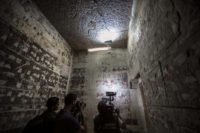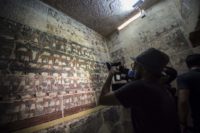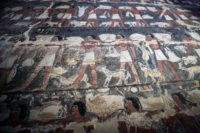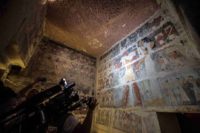 The tomb of Mehu in the the Saqqara necropolis is open to visitors for the first time since it was discovered in 1940 and it was worth the long wait. Mehu was a vizier at the court of Sixth Dynasty pharaoh Pepy (ca. 2300 B.C.), a position of great power in the pharaonic administration. His tomb was designed to bear eternal witness to his high rank. It is a mastaba, a mud brick rectangular structure with a flat roof, of monumental size in a prime location 20 feet south of the southern enclosure wall around the step pyramid of Djoser.
The tomb of Mehu in the the Saqqara necropolis is open to visitors for the first time since it was discovered in 1940 and it was worth the long wait. Mehu was a vizier at the court of Sixth Dynasty pharaoh Pepy (ca. 2300 B.C.), a position of great power in the pharaonic administration. His tomb was designed to bear eternal witness to his high rank. It is a mastaba, a mud brick rectangular structure with a flat roof, of monumental size in a prime location 20 feet south of the southern enclosure wall around the step pyramid of Djoser.
 When it was excavated by an Egyptian mission led by Egyptologist Zaki Saad, the tomb was found to contain one long, narrow corridor with six chambers. A sarcophagus and lid were found in the main burial chamber, but it was what was on the walls that made the greatest impression. Mehu’s name and titles were inscribed there; he had 48 of them, including “the scrub of the royal documents” and “Head of the Juries.” The accolades were enhanced by exceptional paintings covering the walls of four of the chambers.
When it was excavated by an Egyptian mission led by Egyptologist Zaki Saad, the tomb was found to contain one long, narrow corridor with six chambers. A sarcophagus and lid were found in the main burial chamber, but it was what was on the walls that made the greatest impression. Mehu’s name and titles were inscribed there; he had 48 of them, including “the scrub of the royal documents” and “Head of the Juries.” The accolades were enhanced by exceptional paintings covering the walls of four of the chambers.
Dr. Mustafa Waziri Secretary General of the Supreme Council of Antiquities said that the tomb is one of the most beautiful in Saqqara Necropolis because it still keep its vivid colours and distinguished scenes. Among the most strange scenes is the one depicting the marriage of crocodiles with the existence of a turtle.
Among the most important scenes shown on walls are those featuring the owner of the tomb during hunting in jungle or fishing as well as those showing the good harvesting scenes, cooking and dancing acrobatic dance, which was not previously shown in Saqqara before the sixth Dynasty.
Another inscription of major archaeological significance is the name of the deity Khenti-Amentiu, an early iteration of Osiris. Before the discovery of the tomb, references to Khenti-Amentiu had only been found in Upper Egypt. Mehu’s walls were the first evidence that he was worshiped in the Nile delta as well.
 Mehu’s tomb was a family affair. Buried in two of the other chambers were his son Mery Re Ankh and grandson Hetep Ka II. This is another testament to Mehu’s power because most royal officials of his time were not allowed to be buried with their families. That privilege was usually reserved for the pharaoh. Both of Mehu’s descendants had important jobs and many titles, although nowhere near as extensive and important as their father/grandfather’s. Mery had 23 titles engraved on the wall of his chamber; Hetep 10.
Mehu’s tomb was a family affair. Buried in two of the other chambers were his son Mery Re Ankh and grandson Hetep Ka II. This is another testament to Mehu’s power because most royal officials of his time were not allowed to be buried with their families. That privilege was usually reserved for the pharaoh. Both of Mehu’s descendants had important jobs and many titles, although nowhere near as extensive and important as their father/grandfather’s. Mery had 23 titles engraved on the wall of his chamber; Hetep 10.
 The tomb has undergone a program of restoration to showcase the color and richness of the wall paintings. The Ministry of Antiquities has endeavored to stabilize the paint and develop a subtle, non-invasive but functional lighting system to allow visitors to see the beautiful 4,000-year-old art without damaging it.
The tomb has undergone a program of restoration to showcase the color and richness of the wall paintings. The Ministry of Antiquities has endeavored to stabilize the paint and develop a subtle, non-invasive but functional lighting system to allow visitors to see the beautiful 4,000-year-old art without damaging it.